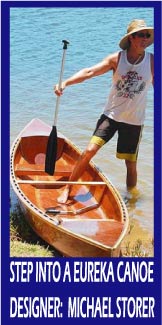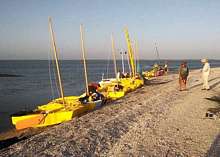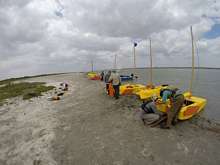
 Custom Search
|
| boat plans |
| canoe/kayak |
| electrical |
| epoxy/supplies |
| fasteners |
| gear |
| gift certificates |
| hardware |
| hatches/deckplates |
| media |
| paint/varnish |
| rope/line |
| rowing/sculling |
| sailmaking |
| sails |
| tools |
| join |
| home |
| indexes |
| classifieds |
| calendar |
| archives |
| about |
| links |
| Join Duckworks Get free newsletter CLICK HERE |
|
|
| Sailing Lessons - Texas 200 Style - Part One |
by Sean Mulligan - Lake Havasu, Arizona - USA |
|
"Scout, Scout, Scout. You're not gonna make it through here.. You're gonna have to turn around and find a deeper channel another way." The radio call was much appreciated but it was about 30 seconds too late. At the exact time the words "You're not gonna make it" were emitting from the VHF's speaker, Scout's bow was sliding up hard onto a mud bank at a solid 4 knots. We were aground on a lee shore that was about 8 inches under water in the middle of a huge bay. The sun was getting low and I wasn't sure where our eventual destination was except that we still had around 8-10 miles to go and that I was not familiar with it. The rest of the group (in the shallower draft "ducks") were making it across the mud bank without me. This was not good. The answer to this situation suddenly became crystal clear. Suck it up, figure it out, and get on the gas baby! Dayight's burnin'. This is the Texas 200! I've been sailing for about 40 years now. After a youth of windsurfing and beach-cats, my adult years have been consumed with number of different fiberglass production sloops ranging from 17 to 23 ft. I devour everything I can find in print about sailing this size-range of boats, for this is where my budget allows me to participate in a sport often thought of as strictly "a playground for the rich". It's not.
Many years ago I came across a sailing magazine called Small Craft Advisor (SCA). Now here was the magazine for me. No 45 footers in there for a cool million bucks. Nope! This was a magazine that focused on small sailing vessels, many like what I sailed. The fact that it is published bi-monthly meant waiting for a new issue to come out with great anticipation, and when it did, sitting down and reading it cover to cover in one day. Then re-reading it over and over for the next two months while I awaited the next issue. One thing that I noticed in SCA was that there were a lot of articles about boats that seemed "different" to me. They weren't the standard fiberglass production sloop. These were owner built, many of plywood, and had all kinds of what I considered "non-standard" rigs on them that I really didn't understand. Gaff rigs, yawls, cat ketchs, standing lugs, balanced lugs, lateen - all these different rigs. Although I enjoyed the articles, I truthfully did not give the plywood, hard chined boats with "non-standard" rigs much respect. I think that if you had asked me back then, my thoughts would have been that these guys were truly yearning to have a production sloop like mine, but for whatever reason they were not able to, so they "had to settle" for whatever they could cobble together just to get them on the water. I realize now how uneducated and arrogant that viewpoint was. I am embarrassed to tell that to you, but it's the truth. I found myself looking for more "adventure" and started doing some longer distance coastal events in my production 23 footer. Some of them were in the 100 mile distance range and requiring sailing up to 20nm offshore overnight . At the same time that I was feeling my oats, I really began to notice articles about events like The Everglades Challenge, Texas 200, Florida 120, the OBX 130, etc etc etc. Wow! These guys were seriously taking these small home-built, sub-standard boats on races even longer than the ones I was patting myself on the back for, for doing it in a 23 foot 6500lb boat? I was intrigued. The articles kept coming and my interest keep growing.
In a quest for more info, I went to the internet. There I searched out the websites for these events. What I found blew me away. It rapidly became evident to me that I had seriously underestimated what was going on here and began researching more and more info - the events, boats, and people sailing them. I was very fortunate to be able to meet some of the folks that I was reading about when they came to my home town for the Havasu Pocket Cruisers Convention. That was the cincher. Immediately upon engaging these guys in conversation, I realized that my assessment of both the sailors and the boats was way, way off. They did not sail homebuilt boats because they had to. They sailed them because they wanted to. They were not beginners, "newbs", or unable to afford a fiberglass production boat. These sailors had intimate relationships with vessels that they created with their own hands. The had in-depth understanding of the design and physics involved in building a boat, much more so than most. They were sailors that reveled in the satisfaction of sailing the vessels that they themselves built. They could build them, they could fix them, and they could modify them to make their characteristics fit exactly the type of sailing they wanted to do. They had working knowledge of many different types of sail rigs, far beyond the standard sloop that so many of us consider the norm. The rigs that they chose were chosen because they filled the bill, they worked, they were efficient, and made sense for the particular sailing conditions that boat was built for. It rapidly became apparent that in this crowd boats were not treated as jewelry, but rather as a partner in a relationship working towards a common goal. They were expected to perform and the order of the day, every day - Form Follows Function. The boats these guys sailed look different. Heck, many of them are missing the front two feet of the hull! Or so and uneducated eye would think. Truth be told, the pram bow design is intended to provide more bow flotation and eliminate the unused one to two feet at the front of the boat that most of us carry. "That thing must just bash into waves - how could it possibly sail well", another comment based on ignorance of the fact that designed correctly, that pram bow seldom if ever "bashes a wave". Rather, it glides over them with massive floatation and useable storage space. I had a lot to learn. I decided I had to see what all this small homebuilt boat stuff was about. Eventually, I became extremely interested in a particular design of boat by a gentleman named Matt Laydon. By a chance set of circumstances, I had an incredible opportunity to acquire an almost complete model of his "Paradox" sharpie. Before I knew it the Paradox was in my driveway. It took me 6 or 7 months to get around to finishing the boat and to start sailing her. This boat was like nothing I had ever sailed. Most of my production boat buddies thought I was nuts. They wanted to increase their boat's size. I just cut mine in half. My goal was to explore what the boat was truly capable of and to see if I thought I might want to try one of these long distance adventures that caters to the variety of owner-built designs. Over the next few months I sailed the boat in increasingly challenging conditions and I was amazed. I was having more fun sailing this micro-cruiser than I had had in years. Still, I was unsure about joining in on one of these long distance challenges. To explore it further, I set up a 50 mile engineless challenge for myself on my local lake to see: 1. If I could do it, and 2. If I would enjoy it. I did it. The answers? Yes and yes!
Sailhavasu - sailhavasu.com
My blog - www.fullnby.com
My YouTube channel - www.youtube.com/user/nebwest2 To be continued... |
To comment on Duckworks articles, please visit one of the following:
|
 |






